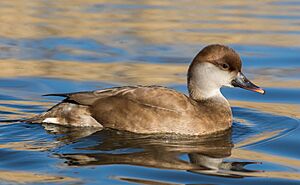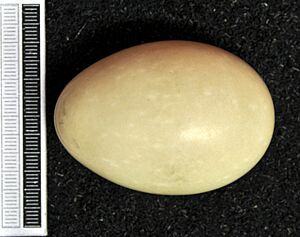Red-crested pochard facts for kids
Quick facts for kids Red-crested pochard |
|
|---|---|
 |
|
| Male | |
 |
|
| Female | |
| Conservation status | |
| Scientific classification | |
| Genus: |
Netta
|
| Species: |
rufina
|
 |
|
| Range of N. rufina Breeding Resident Non-breeding | |
The red-crested pochard (scientific name: Netta rufina) is a type of large diving duck. Diving ducks find their food underwater. Its scientific name comes from two old languages: Netta is Greek for "duck," and rufina is Latin for "golden-red." This name perfectly describes its beautiful colors!
These ducks like to breed in wet, low-lying areas like marshes and lakes in southern Europe. Their homes stretch all the way from the Black Sea to Central Asia and Mongolia. When winter comes, many red-crested pochards fly south. They spend the colder months in places like the Indian Subcontinent and Africa.
Contents
What Does It Look Like?
The adult male red-crested pochard is easy to spot. It has a bright orange head that looks rounded. Its bill is red, and its chest is black. The sides of its body are white, its back is brown, and its tail is black.
The female looks quite different. She is mostly a pale brown color. Her back and the top of her head are darker. Her face, however, is whitish. Young males, or males during a special time called "eclipse," look similar to females but still have red bills.
These ducks are very social birds. They often gather in large groups during winter. Sometimes, they even mix with other types of diving ducks, like common pochards.
What Do They Eat?
Red-crested pochards find their food in two main ways. They can dive deep underwater to catch food. They also "dabble," which means they tip their bodies upside down with their tails in the air. This lets them reach plants and food just below the surface.
They mostly eat aquatic plants that grow in the water. They tend to tip upside down for food more often than many other diving ducks.
Sounds They Make
You might hear the male red-crested pochard make a soft, wheezing sound. It sounds a bit like veht. The females have a different call. They make a series of rough, scratchy sounds that go vrah-vrah-vrah.
Life Cycle and Nests
Red-crested pochards build their nests close to the water's edge. They hide their nests among the plants. A female duck usually lays between 8 and 12 eggs. These eggs are a pale green color.
Red-Crested Pochards in the UK
It can be a bit tricky to know how many red-crested pochards are truly wild in the British Isles. Over the years, many of these ducks have escaped from collections. Some have also been purposely set free. On top of that, some natural visitors fly over from Europe.
However, it seems most likely that the ducks now breeding in the wild in England are from these escaped birds. They have created a successful wild population. You can often see them in areas like Gloucestershire, Oxfordshire, Northamptonshire, and Leicestershire.
Protecting These Ducks
The red-crested pochard is an important bird. It is one of the species protected by the Agreement on the Conservation of African-Eurasian Migratory Waterbirds (AEWA). This agreement helps protect birds that fly long distances between Africa, Europe, and Asia.



